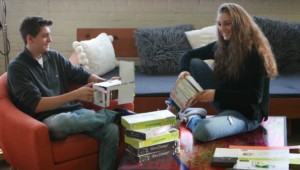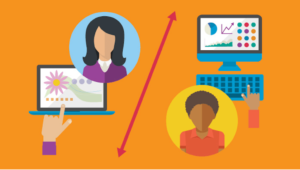5 Lessons for Teachers from FETC

By Rachelle Dene Poth
Last week I attended the Future of Education Technology Conference (FETC) for the first time in Orlando, Florida. Having attended many edtech conferences over the past few years, including ISTE and several at the state level, I had a decent idea of what to expect—and I wasn’t disappointed.
The ideas shared by the panelists and speakers were fascinating, and I found myself surprised by the amount of food for thought I received from the conference.
Because I found the experience to be valuable, I wanted to share what I consider to be the five most impactful lessons I learned at the conference:
1. Relationships matter. One of the key takeaways for me is that it’s important to develop and maintain a robust group of teacher-friends who will inspire and learn with me. Having these relationships can help me stay creative, and stay engaged in my teaching.
Getting the week started by connecting with “edufriends” and the members of my personal learning network (PLN), and then spending time with that group sharing ideas, having fun and learning from each other felt like a breath of fresh air. And I don’t think I was alone in that feeling—there was a great excitement at FETC surrounding the opportunity to reconnect with old friends or meet online friends face-to-face for the first time. It was easy to see how thrilled people were for the opportunity to engage in the educator community.
2. Think big, try new things and keep at it. Educators need to be encouraged to do things that are different, and we should be “thinking big.” I heard these words in one of the sessions I attended, and that seemed to be one of the major recurring themes in the conversations I heard during the conference.
I took the “Future of EdTech” track as my main focus, but also looked for sessions focused on personalized learning, blended learning and the use of augmented and virtual reality in the classroom. I was impressed by all of them, and found that pretty much everyone agreed that today’s educators need to take risks with their curriculum and EdTech, to keep working toward improvement, to involve students in the process, and to face challenges when they come up.
3. We haven’t seen the last of EdTech innovations, and seeing new developments in person can be a great way to stretch your thinking about your own classroom. Taking time to walk through the expo hall and talk with edtech representatives, see innovative tools in action and ask for insight on how these tools can help to engage and empower students was well worth it. For example:
- The presentations offered at the Buncee booth demonstrated how Buncee provides many possibilities for creating multimedia presentations and creates diverse learning opportunities, regardless of content area or level taught.
- Nearpod was another favorite of the crowd—there was always a line at their booth, with many people eager to learn more about virtual reality field trips and see VR headsets in action. Perhaps this was to be expected, as bringing learning experiences to life and immersing students in their learning environment is a goal of almost every educator.
- There were several booths offering some really engaging ways to build student skills in content areas, including ABCYa and Woot Woot Math for math, Kidblog and StoryboardThat for writing and creativity, Flipgrid for assessments and promoting student voice, and some fun new tools like Peekapak for social-emotional learning (SEL) activities. Each booth represented a goal for student learning, and the representatives were happy to answer questions, hear feedback and exchange ideas.
- Not to be missed was the opportunity to stop by each of the “Poster Session” areas to learn about topics such as Augmented and Virtual Reality and see some of the digital tools and apps in action (and how they could benefit students). One standout to me was AugThat, and I also immediately saw lots of uses for how Bloxels Edu could help in creating classroom games.
- The makerspaces and 3D printing areas were also a hit, with each presenter offering samples of cool, student-created work, QR codes with resources available for attendees, and great opportunities to make new connections and bring the learning back to the classroom.
4. Keep things student-centered. I really enjoyed the variety of workshops offered during the conference, and even had the opportunity to present a workshop on digital tools for flipped learning. My session focused on how to use these tools to not only flip where and when students are learning, but also the roles of who is leading the lesson in the classroom (the movement from student-centered to student-driven learning).
I didn’t necessarily intend for this to be the case, but in retrospect I realized that I confirmed one of the most common themes of the conference: that empowering students with choice and voice is a crucial aspect of EdTech implementation if our goal is student engagement and deeper learning. Having the time to learn from other educators and see the impressive student work examples that came out of this mindset was fantastic.
5. Special events and meetups can be great ways to engage teachers in community-building. As educators, we know that students can’t (and shouldn’t) spend all of their time in the classroom. Similarly, teachers can’t spend all of their time in convention halls. In addition to the events held at the Convention Center, there were a number of other events I really enjoyed, such as the #coffeeedu meetups and dinner receptions hosted by different edtech companies, PLN groups and special interest groups.
These events really provided a nice environment in which attendees could continue to build their personal learning networks and keep the conversations going. So much learning goes on during the day, that the evening can be a great chance to share experiences with a group.
I also have to mention the EdTech Karaoke (ETK) time, organized by SymbalooEDU. The singers at FETC put on a great show, and it was a perfect way to close out the FETC experience and solidify the bonds developed at the conference.
My Overall Impression of FETC
Conferences like FETC are fantastic experiences that provide diverse, personalized learning opportunities. Once a conference ends and you settle back into your regular routine, you will have an opportunity to really let the things you learned sink in.
Take a look at your conference materials, review the #FETC Twitter feed, find one thing to focus on and try something new. Rely on your PLN and connect with your friends—just because a conference ends, doesn’t mean the conversation and learning have to.
It’s all about connecting and working toward personal and professional growth, taking some risks and using new knowledge and experiences to empower our students, our educators, our community and ourselves.
I would highly recommend educators make a note on their calendar to attend FETC next year.
For more, see:
- 25 Can’t-Miss Education Conferences in 2017
- 10 Big Ideas for Better Education Conference & Professional Learning
- TCEA: “Unconferencing” Professional Learning Conferences
Rachelle Dene Poth is a Foreign Language and STEAM Teacher at Riverview Junior Senior High in Oakmont, PA. Follow her on Twitter at @rdene915.
Stay in-the-know with all things EdTech and innovations in learning by signing up to receive the weekly Smart Update.





0 Comments
Leave a Comment
Your email address will not be published. All fields are required.